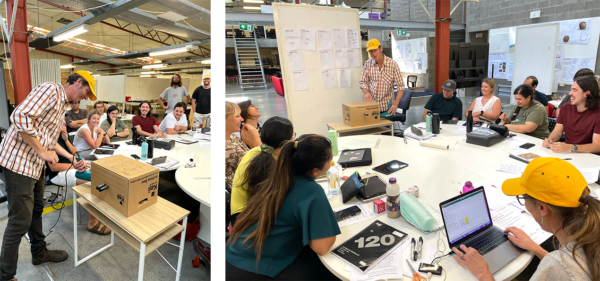EDUCATION: HH works with UON Architecture students
‘Hot House’
Healthabitat is working with Dr Jasper Ludewig to deliver a studio stream in the School of Architecture and Built Environment at The University of Newcastle, Australia for Masters students called ‘Hot House – Heat, Health and Energy Insecurity in Indigenous Housing’.

Image: Students experience the climate chamber at USYD
Using real house designs and details from a deidentified NT community project, students are being asked to develop a suite of design strategies for mitigating thermal stress in remote community housing. Their strategies will be detailed and costed to ensure they are viable options on the ground in our project work before being considered for implementation.
Jasper has curated a rich semester of experts in this area to wrap around the focus of the project. The students will be hearing from Healthabitat, Andrew Broffman – Principal at The Fulcrum Agency, Tess Lee from the Housing for Health Incubator , and Simon Quilty from Australia National University among others, including a visit to the Climate Chamber at USYD to feel in real life what ‘hot’ is.
Heat and Health Research Incubator at USYD
Students visited the Climate Chamber at the Heat and Health Research Incubator at USYD. Researchers James Smallcomb and Grant Lynch, spent the session explaining to students the physiological effects of heat on the body and its responses and hence the risk of climate change on people, in particular children and elderly people.
The Chamber was set to 42C ambient temperature with 20% humidity and the 20 students gathered inside to experience the heat and how their bodies responded to the climate. The researchers continued to experiment with fans and turning on a heat lamp to simulate effects of Black Bulb Temperatures and radiant heat. To many students’ disbelief, the use of fans at 42C increased discomfort as the temperature was higher than skin temperature (35C) which meant their bodies were taking on heat (evaporative heat gain) rather than cooling down via sweating. For the second round in the chamber, it was set to 32C ambient temperature and 40% humidity and the use of fans aided in cooling the body via evaporating sweat as the temperature was then lower than that of the skin temperature.
The researchers also discussed the importance of advocacy and public education about how to use technologies in our homes to cool us, including shifting our thinking around cooling down houses to an esky level 24C as this then decreases our human resilience to adapt and respond to extreme heat events. Rather, thinking about air-conditioners as another tool to help lower the temperatures below skin level and using fans and effective ventilation to help us be comfortable.
Designing for Thermal Comfort workshop
Healthabitat ran a one day intensive that has been developed and used over many decades in the teaching of climate adaptation at universities.
The exercise simulates cooling people. Using a model person and an embedded data logger, the students were required to make simple practical changes to the model people to keep them cool against the ambient temperature.

Image: HH runs ‘Designing for Thermal Comfort’ workshop with model people and data loggers
Thanks to Jasper for curating a great stream offering for these 4th and 5th year architecture students. Content such as this, is important to introduce at the foundational level of architectural experience and we have no doubt it will be formative for these students of architecture and their future contributions to the built environment.









